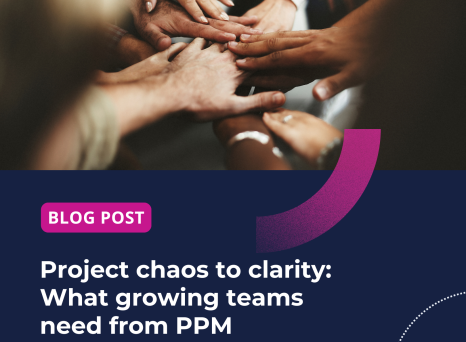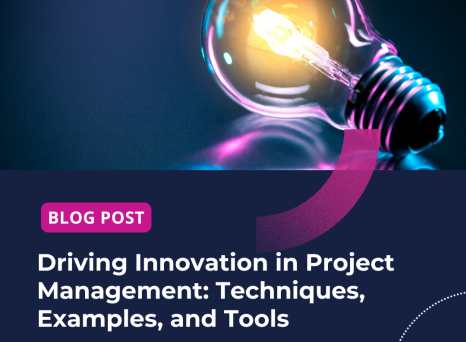What is the Project Enablement Framework?
When you encounter a project checkpoint, what thoughts come to mind? If your initial response revolves around delays and obstacles, it might be time to adopt a fresh perspective, and that's precisely where the Project Enablement Framework comes into play.
Project enablement re-envisions the gates within the traditional stage-gate model to bring structure to non-processed-centric organizations. What does this mean? Well, let’s take a NASCAR race as an example.
Racecars need to undergo regular pit stops to maintain their performance and ensure they can continue the race. In a different approach, these pit stops can be seen as potential obstacles, causing delays and disrupting the race flow.
However, with a project enablement framework, these pit stops are reimagined as strategic checkpoints along the race. Instead of slowing the driver, these checkpoints become opportunities for the team to fine-tune the car's performance, make necessary repairs, and refuel efficiently.
As a result, the driver now has a higher chance of winning the race compared to not having stopped. In the same way, Project Managers can strengthen their project selection and execution by changing their process as an enabler, to ensure the project moves forward.
If your stage-gate processes are cumbersome, project enablement may be helpful for moving your new product development forward.
Why Processes are Critical for the Success of New Product Development (NPD) Organizations
Forward-thinking companies construct and propel new products to drive the expansion of their organizations just like a race car uses its pit stops as an advantage to win the race. The manner in which they navigate this growth provides value in portfolio, program, and project management (PPM).
For instance, companies that outpace their competitors in growth possess specific elements in their New Product Development (NPD) processes such as:
- Prominently visible and inclusive at every stage, from selection to launch.
- Empowerment as the driving force behind bringing products to market.
- Facilitators of project success and adaptability.
- Alignment with strategy, resources, and decision-makers.
To bring products to the market successfully, processes should encompass the entire journey, from generating ideas to selecting, launching, and post-launch activities. High-performing companies employ processes that are visible, inclusive, and empowering, effectively aligned with strategy, resources, and decision-makers. It is imperative for everyone within the organization to comprehend and utilize these processes to enable success. However, adaptable processes aren't one-size-fits-all; they are well-prepared to cater to the individual needs of projects.
As projects gain support and approval, they receive funding and backing for product development, enabling the company to fulfill its strategic objectives.
Stage-Gate Alternatives: What To Do and How To Do It
To unlock the value of effective portfolio management and project execution, both aspects are crucial for companies.
- What to do - Select the appropriate projects and align investments with the overall strategy.
- How to do it - The deployment of resources and implementation of stage gates play a vital role in ensuring successful project execution.
That being said, imagine a specific division within a larger organization aiming to establish a process for commercializing innovations. Nevertheless, this unit encountered initial challenges such as project delays and failure to meet key performance indicators (KPIs). In order to have a good outcome, the company needed to focus beyond simply ensuring the effectiveness of the process, but understanding how to manage a portfolio.
The Benefits of a Better Capacity Model
To address the issue, a capacity model, was developed. Collaborating with functional leads, the team aimed to drive business growth and support innovation consistently across groups and teams.
Upon analysis, it became evident that the organization exceeded its capacity, with an excessive project load in the portfolio. Bottlenecks also emerged as some groups that had less capacity than others. Aligning the available innovation capacity in New Product Development (NPD) allowed the steering group to manage the portfolio within defined project capacity constraints, resulting in a highly effective process.
The new capacity model proved to be a simple yet powerful tool, enabling leadership to engage better with project and portfolio management. With an improved framework, projects were executed on time, and overall execution improved. Strategic project selection based on capacity ensured correct implementation.
As a result, employee satisfaction and project KPIs experienced notable growth.
Case Study: Enhancing Project Capabilities for a Toy Company with the Introduction of SIPEC
Finally, let's explore the experience of a toy company that undertook a transformation of its digital project intake process. Collaborating with the Chief Information Officer (CIO), they sought to revamp their product development process to align with both the business objectives and the unique company culture.
As a toy company, their culture thrived on creativity and enjoyment. Utilizing a project enablement framework, an external expert assisted them in developing a portfolio enablement system that embraced fun branding while integrating best practices to strengthen their product development process. The key components of the transformation included:
- SIPEC brand: A portfolio enablement committee, known as the Strategic Information Technology Portfolio Enablement Committee (SIPEC), was designed to align with the company's culture. It played a crucial role in facilitating the project lifecycle and intake process.
- Positive enablement tone: SIPEC was established with a clear purpose of supporting project teams and enabling progress and success.
- Gates as pit stops: Throughout the project, product progress was marked by "gates" that served as resourcing checkpoints and opportunities for new sprint cycles.
The introduction of this new and engaging process sparked a renewed sense of enthusiasm within the internal teams, both for product development and for guiding innovative projects within the portfolio.
Learn More in Our Webinar
To find out more about the Project Enablement Framework and how these best practices apply in today’s organizations, learn more in our webinar, “Bringing PPM Structure to Non-Process Centric Organizations.” where Scott Lamb, goes more into detail about the Project Enablement Framework with traditional Stage Gate processes and explains how your organization can revamp product development to improve KPIs and project execution.


